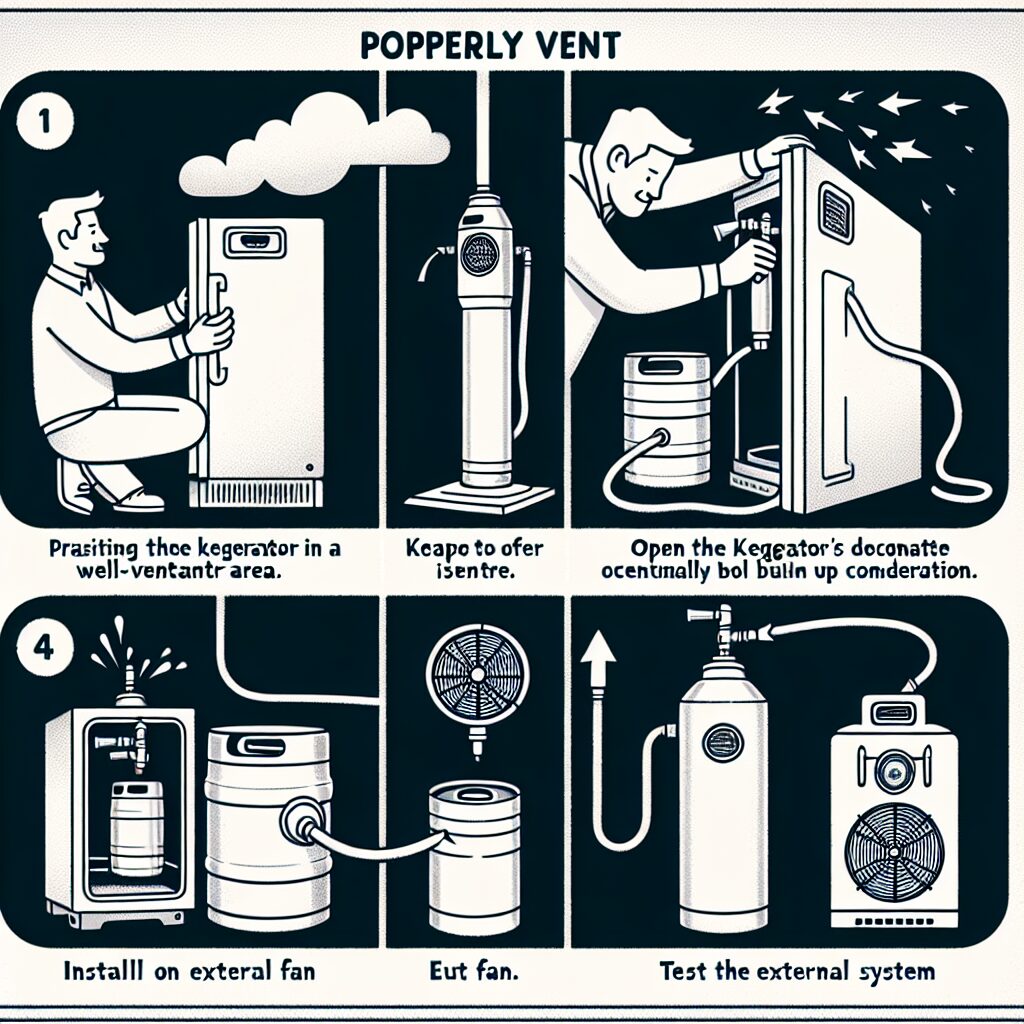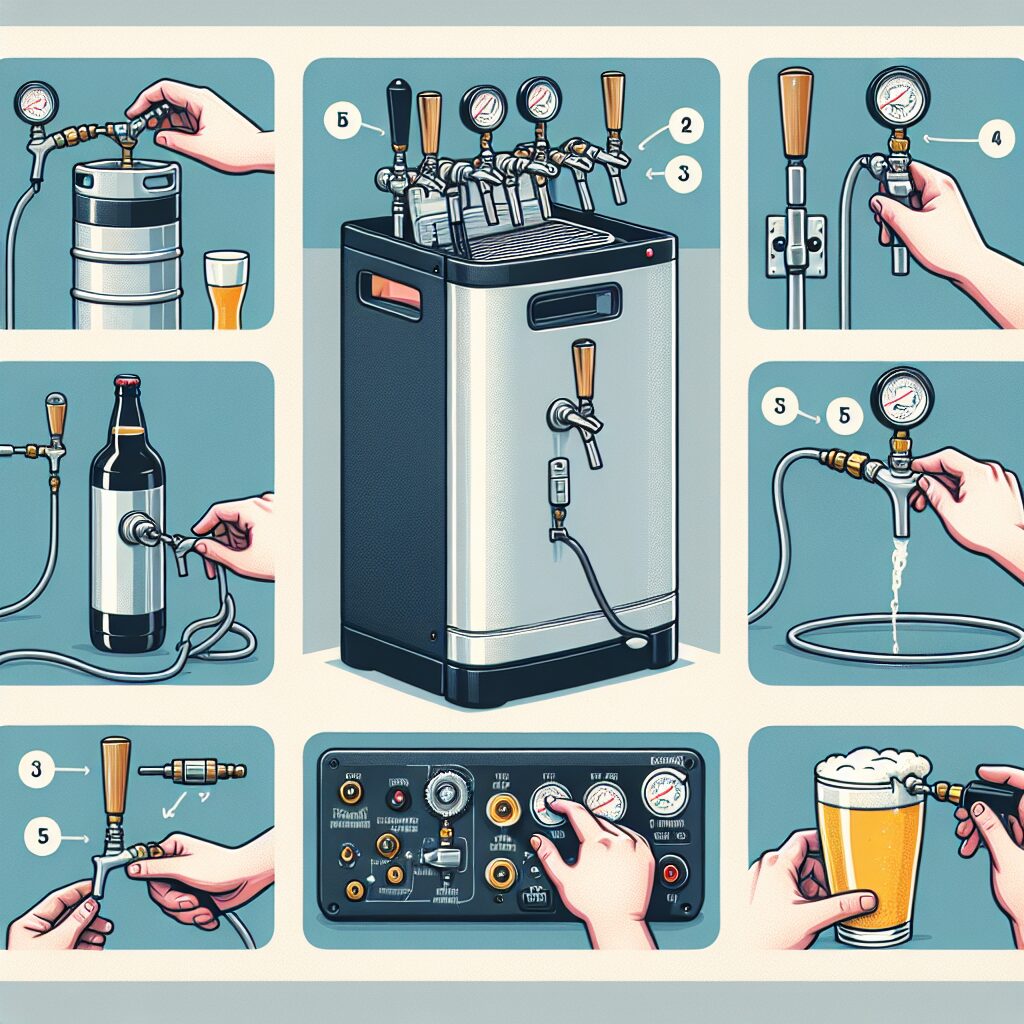As an Amazon Services LLC Associates Program participant, we earn advertising fees by linking to Amazon, at no extra cost to you.


May 11, 2024 … … proper ventilation. Add your … vents and ensuring the fans are working properly. … kegerator hooked into the same system so …
Best Practices for Kegerator Placement
Here are some key points to ensure your kegerator is perfectly placed for optimal performance and accessibility.
- Choose a spot with good airflow. Avoid tight corners that trap heat.
- Keep it away from direct sunlight. Sun exposure can raise internal temperatures.
- Ensure easy access for serving. Place it near seating areas for social gatherings.
- Level the unit during installation. An uneven surface affects performance and dispensing.
- Consider using smart tech for monitoring. It helps keep track of temperature and airflow.
Monitoring Temperature and Airflow in Kegerators
Most people think that simply placing a kegerator in a corner is enough. I believe that actively monitoring temperature and airflow is key to optimal performance. Without proper monitoring, you risk serving flat or spoiled beer.
Consider investing in a temperature monitoring system. These can alert you to fluctuations that could impact your beer’s quality. According to KegWorks, “Proper ventilation will ensure the longevity and performance of the system.” This means you can’t just set it and forget it!
Some folks stick with traditional methods, like checking the temperature manually. But I think that’s outdated. Smart technology can provide real-time alerts right to your phone. It’s that simple!
Most people overlook the importance of airflow. Without it, your kegerator can overheat. I recommend ensuring there’s at least 2-3 inches of clearance around your unit. This simple step can drastically improve performance.
Lastly, consider the layout of your space. Positioning your kegerator near seating areas can create a more social atmosphere. It’s all about making your beer experience enjoyable!
Apr 12, 2022 … … ventilate properly and thus may struggle to maintain a proper temperature. They make purpose built kegerators for this that vent out the front.
DIY Kegerator – Help picking out a Mini Fridge : r/Homebrewing
Simply place it under an existing counter. Ready To Be Put Into Action: Specifically designed for kegerator conversion, this refrigerator arrives with a …
Jun 19, 2022 … … place I would have the space for it would be my room. Thanks guys … Venting a keg via the PRV is loud, I can't imagine what venting a …
Is it dangerous to have a keezer/kegerator in the room I sleep in . : r …
Jul 20, 2017 … This site may earn a … Is it a must do go with an under the counter model or if I vent properly out the back can I use standalone unit?
Outdoor Kitchen Kegerator | Homebrew Talk – Beer, Wine, Mead …
Dec 8, 2023 … If vents 2 & 3 sounded almost as loud as #1 you still have way too much CO2 in the beer…continue venting until the amount of gas released is …
Innovative Ventilation Solutions for Kegerators
Most people think standard ventilation is enough for kegerators. I believe that innovative solutions can vastly improve performance. Consider adding exhaust fans or louvered doors to enhance airflow.
Many enthusiasts overlook the benefits of smart technology. I suggest integrating temperature monitoring systems. These can alert you to any fluctuations, keeping your beer at its best.
In my experience, placing a kegerator in a custom-built bar can be a game changer. It allows for creative designs while ensuring proper ventilation. According to KegWorks, “Proper ventilation will ensure the longevity and performance of the system.”
Using carbon-neutral CO2 sources is another innovative approach. This not only helps the environment but also enhances your kegerator’s efficiency.
Lastly, consider insulation techniques that minimize the need for extensive ventilation. This can lead to better energy efficiency and consistent beer quality.
Oct 21, 2024 … If you do, you have a defrost problem. It's blocking the vent that goes to the fridge, not allowing airflow. Or best case scenario, the door …
How to Reset Kenmore Elite Fridgetext=to Cool Normally There Are …
What size keg do you need for your event? This quick video on the anatomy of … Binging and Purging Cycle Vent. 9373Likes. 0Comments. 51Shares.
Feb 28, 2024 … … vent #trauma #deepthoughts #meaning #hypersexual · dubbiessventss … What size keg do you need for your event? This quick video on the …
Oct 28, 2024 … high humidity is when your vent is closed. it's for anything … kegerator foam problem solved! original sound – user151090540880. 142 …
Recommended Ventilation Clearances
Proper ventilation is a game changer for your kegerator. I recommend keeping at least 2-3 inches of clearance on all sides. This space allows for effective airflow and prevents overheating.
Most people think it’s okay to shove their kegerator into a tight corner. I think that’s a huge mistake! Poor airflow can lead to compromised beer quality and a malfunctioning dispenser.
Consider the placement carefully. Avoid direct sunlight and heat sources like ovens. These can wreak havoc on temperature control.
Some enthusiasts get creative. Instead of a traditional setup, they build custom bars with enhanced ventilation systems. This not only looks great but keeps everything running smoothly.
As Dave Buchanan from KegWorks says, “Proper ventilation will ensure the longevity and performance of the system.” So, don’t skimp on this aspect!
Lastly, think about monitoring your airflow. Installing smart technology can alert you to any ventilation issues. It’s a simple step that makes a big difference.
Signs of Poor Ventilation in Kegerators
Recognizing the signs of poor ventilation is key to maintaining a well-functioning kegerator. Here are some telltale indicators that your unit might be struggling with airflow.
- Warm beer is a clear red flag. If your beer isn’t staying cold, check for airflow issues.
- Frost buildup on the kegerator’s exterior. This can indicate improper heat dissipation and ventilation problems.
- Unusual noises from the compressor. If it’s working overtime, it might be due to restricted airflow.
- Increased energy bills. A kegerator struggling with ventilation will consume more power.
- Beer lines tasting off. Poor ventilation can lead to stale flavors and quality issues.
Common Errors in Kegerator Ventilation
Avoid these common mistakes to keep your kegerator running smoothly and your beer tasting great.
- Ignoring clearance space. Many folks think tight spaces are fine. But I believe you need at least 3 inches around for airflow.
- Placing near heat sources. Some people think proximity to ovens or sunlight is okay. I argue that this leads to overheating and poor cooling.
- Neglecting regular checks. Most users forget to monitor ventilation. I recommend checking every few months to catch issues early.
- Overlooking air circulation. Many assume air will flow naturally. I think you need to actively ensure good airflow around the unit.
- Using inadequate insulation. Some think insulation isn’t a big deal. I say better insulation keeps temperatures stable and improves beer quality.
Choosing the Right Location for Your Kegerator
Finding the perfect spot for your kegerator is a game changer. Avoid direct sunlight and heat sources. This keeps your beer cold and your unit running smoothly.
Most people think aesthetics matter most. I believe functionality should come first. A well-placed kegerator enhances your entertaining experience.
Consider airflow. Leave at least 2-3 inches of clearance around the unit. This prevents overheating and ensures optimal performance.
Some might suggest a corner placement for style. I disagree! Corners restrict airflow. A more open area promotes better ventilation.
Incorporating smart tech can elevate your setup. Imagine monitoring your kegerator’s temperature remotely! This not only ensures quality but also adds convenience.
According to the KegWorks guide, proper placement is key to longevity. So, take your time to choose wisely!
Also, don’t forget about accessibility. Keeping your kegerator near seating areas makes it easy for guests to grab a drink.
All these factors contribute to a better beer experience. A well-placed kegerator is a happy kegerator!
Impact of External Heat Sources
Understanding how external heat sources affect kegerator performance is key to maintaining optimal beer quality.
- Direct sunlight can raise internal temperatures. This leads to inefficient cooling and poor beer quality.
- Placing your kegerator near ovens or heaters is a bad idea. These heat sources force the compressor to overwork.
- Consider the overall layout of your space. A well-thought-out placement ensures better airflow and longevity.
Importance of Proper Kegerator Ventilation
Ventilation is the lifeblood of a kegerator. Without it, you’re risking beer quality and equipment longevity. I’ve learned that giving your kegerator enough breathing room is non-negotiable.
Many people think a kegerator can be tucked anywhere. I disagree because proper airflow is crucial. A clearance of 2-3 inches on all sides is a must!
Direct sunlight? Forget about it! Heat sources can turn your kegerator into a warm beer factory. Keep it cool and shaded for the best results.
Some folks might say, ‘Why not just use a fan?’ But I think installing exhaust systems is a smarter move. It enhances airflow and keeps your beer at the perfect temperature.
As quoted by Dave Buchanan from KegWorks, “Proper ventilation will ensure the longevity and performance of the system.” That’s a lesson I’ve taken to heart!
And let’s not forget about smart tech. Incorporating temperature monitoring can save your beer from spoiling. It’s a game changer for anyone serious about their brews.
In short, proper ventilation is key. Don’t skimp on this aspect!


What are the signs of poor kegerator ventilation?
Poor kegerator ventilation can lead to a range of issues. First, if you notice warmer beer or inconsistent carbonation, that’s a red flag. Overheating can compromise beer quality.
Another sign is excessive noise from the compressor working overtime. If you feel heat radiating from the unit, it’s time to reassess ventilation. Lastly, check for condensation buildup; it’s a clear indicator of airflow problems.
Most people think a kegerator just needs a corner, but I believe in maximizing airflow. Consider adding exhaust fans or louvered doors. This can create a more efficient cooling environment, especially in tight spaces.
According to Dave Buchanan from KegWorks, “Proper ventilation will ensure the longevity and performance of the system.” Read more here.
How can I improve airflow around my kegerator?
Most people think that just placing a kegerator in a corner is fine. I disagree because airflow is everything! You need to give it space. A clearance of 2-3 inches on all sides is a must.
Positioning is key. Avoid direct sunlight and heat sources. Trust me, this will save you headaches later!
Many overlook this, but adding smart technology can help. Monitoring systems alert you to temperature changes, ensuring your beer stays fresh. According to KegWorks, “Proper ventilation will ensure the longevity and performance of the system.”
Consider exhaust fans or louvered doors for better airflow. It’s that simple!
What is the best location for a kegerator?
Most people think placing a kegerator in a corner is ideal. I believe that choosing a location with ample airflow is way better. Avoid spots near heat sources or direct sunlight; they can really mess with your beer’s quality.
Consider accessibility too. Keeping it near seating areas makes serving drafts a breeze during gatherings. You want to enjoy the beer, not trek across the room for it!
Some folks overlook leveling their kegerator. An uneven surface can lead to poor performance. Trust me, a little attention to placement goes a long way.
As Dave Buchanan from KegWorks says, “Proper ventilation will ensure the longevity and performance of the system.” So, make ventilation a priority!
For innovative ideas, think about integrating smart technology to monitor airflow. It’s a game changer for keeping your beer at the perfect temperature.
How often should a kegerator’s ventilation system be checked?
I believe checking your kegerator’s ventilation system every few months is a must. This keeps your beer at its best. Many folks think it’s fine to ignore it until issues arise, but that can lead to spoiled beer and wasted kegs.
Regular checks help ensure airflow is clear and that nothing is blocking the vents. If you notice any signs of overheating or poor cooling, it’s time to investigate. I’ve found that proactive maintenance saves a lot of headaches down the line.
Some people might suggest a yearly check, but I think that’s too infrequent. Frequent monitoring can prevent bigger problems. You can even integrate smart tech for real-time alerts!
For a deeper dive into kegerator maintenance, check out KegWorks’ Ultimate Buying Guide. It’s packed with tips!
As an Amazon Services LLC Associates Program participant, we earn advertising fees by linking to Amazon, at no extra cost to you.



